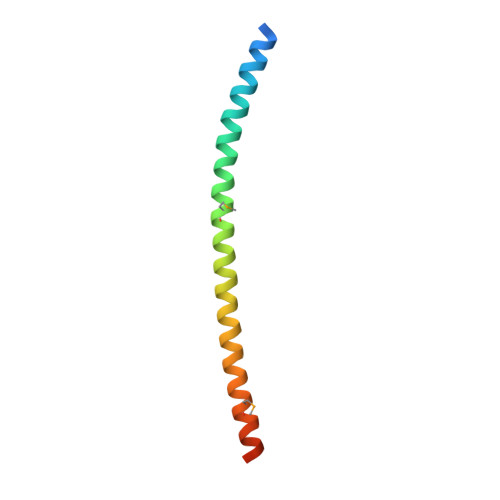The C-terminal region of the plasmid partitioning protein TubY is a tetramer that can bind membranes and DNA.
Hayashi, I.(2020) J Biol Chem 295: 17770-17780
- PubMed: 33454013
- DOI: https://doi.org/10.1074/jbc.RA120.014705
- Primary Citation of Related Structures:
7C7Y - PubMed Abstract:
Bacterial low-copy-number plasmids require partition (par) systems to ensure their stable inheritance by daughter cells. In general, these systems consist of three components: a centromeric DNA sequence, a centromere-binding protein and a nucleotide hydrolase that polymerizes and functions as a motor. Type III systems, however, segregate plasmids using three proteins: the FtsZ/tubulin-like GTPase TubZ, the centromere-binding protein TubR and the MerR-like transcriptional regulator TubY. Although the TubZ filament is sufficient to transport the TubR-centromere complex in vitro, TubY is still necessary for the stable maintenance of the plasmid. TubY contains an N-terminal DNA-binding helix-turn-helix motif and a C-terminal coiled-coil followed by a cluster of lysine residues. This study determined the crystal structure of the C-terminal domain of TubY from the Bacillus cereus pXO1-like plasmid and showed that it forms a tetrameric parallel four-helix bundle that differs from the typical MerR family proteins with a dimeric anti-parallel coiled-coil. Biochemical analyses revealed that the C-terminal tail with the conserved lysine cluster helps TubY to stably associate with the TubR-centromere complex as well as to nonspecifically bind DNA. Furthermore, this C-terminal tail forms an amphipathic helix in the presence of lipids but must oligomerize to localize the protein to the membrane in vivo. Taken together, these data suggest that TubY is a component of the nucleoprotein complex within the partitioning machinery, and that lipid membranes act as mediators of type III systems.
Organizational Affiliation:
Department of Medical Life Science, Yokohama City University, Tsurumi, Yokohama, Kanagawa, Japan. Electronic address: ihay@yokohama-cu.ac.jp.















